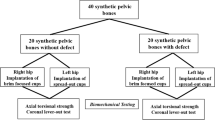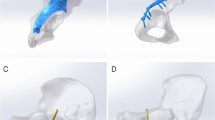Abstract
Using finite element analysis we have studied the pelvic bony socket and compared it with radiological imaging using threaded acetabular cups of three different shapes (parabolic, conical, hemispherical). The two-dimensional model depicted a planar section through a left pelvic hemisphere. In all three cups the stress in the bony socket increased from lateral towards medial. Compressive stress was found on the superior and inferior parts of the cup, but mainly on the superior aspect, seen radiologically as new trabecular bone formation. The maximum compressive stresses were seen in the cranial curvature of the conical cup, with less in the parabolic form and least in the hemispheric form. The tensile stress at the bottom of the socket increased from the hemispheric to the conical shape. Radiological rarefaction gave an indication of lower stress. There was lower compressive stress between the teeth of the threads. This FE model uses computer simulation to predict bony changes with different designs of implant. The ability to simulate biological conditions is a valuable addition to the testing of mechanical strength.
Résumé
Par éléments finis nous avons étudié le cotyle osseux et l'avons comparé avec les images radiologiques faites avec des cupules vissées de trois formes différentes (parabolique, conique, hémisphérique). Le modèle à deux dimensions a représenté une section plane à travers une hémisphére pelvienne gauche. Pour les trois cupules la contrainte dans l'os augmente de dehors en dedans réalisant un toit osseux en pince. La contrainte de compression existe sur les parties supérieure et inférieure de la cupule, mais d'une manière prédominante sur le côté supérieur, radiologiquement représentée par une nouvelle formation osseuse trabeculaire. Les contraintes de compression maximales étaient présentes dans la courbure polaire crâniale des cupules coniques, avec une tendance décroissante de la forme parabolique à la forme hémisphérique. Des contraintes en tension ont été démontrées au fond du cotyle osseux, en augmentant de la cupule hémisphérique à la cupule conique. La raréfaction osseuse radiologiquement visible a représenté la contrainte calculée et moindre de contrainte de compression entre les filets. Ce modèle utilise la simulation informatique pour prédire les changements de l'os selon les différents dessins des implants. La possibilité de simuler des conditions biologiques complète utilement les essais de résistance mécanique.
Similar content being viewed by others
Author information
Authors and Affiliations
Additional information
Electronic Publication
Rights and permissions
About this article
Cite this article
Effenberger, H., Witzel, U., Lintner, F. et al. Stress analysis of threaded cups. International Orthopaedics (SICOT) 25, 228–235 (2001). https://doi.org/10.1007/s002640100252
Accepted:
Published:
Issue Date:
DOI: https://doi.org/10.1007/s002640100252




